Antihistamine ointments in the presence of signs of skin allergies, they are used as a means of symptomatic therapy. The drugs of this pharmacological group act directly on the H1 receptors of epithelial cells, which are sensitive to an increase in histamine.
As the concentration of this substance increases in the blood and tissues of the skin, symptoms of a moderate or acute allergic reaction appear. Antihistamine ointments stabilize general well-being, eliminate signs of the disease in the form of itching, redness, rash, hyperemia.
Record content:
- 1 Classification
-
2 Rating of drugs from the pharmacy
- 2.1 Dermadrin
- 2.2 Fenistil gel
- 2.3 Dimetindene
- 2.4 Allergozan
- 2.5 Chloropyramine
- 2.6 Psilo-Balm
- 2.7 Dimetinden-Akrikhin
- 3 Video about antihistamine ointments
Classification
Antihistamine ointments are prescribed by a dermatologist or allergist to patients who have skin allergy symptoms. Moreover, most of the drugs in this group are approved for use in children, adult men and women, as well as elderly patients. The table below details the classification types of antihistamine ointments.
| Classification of antihistamine ointments | Characteristics of drugs |
| Hormonal | Hormone-based antihistamine ointments are drugs for drug therapy, the active components of which are synthetic hormones, glucocorticosteroids. Biochemicals of this type are produced by the adrenal glands. The mechanism of action of hormonal-based antihistamine ointments is that they activate protein and carbohydrate metabolism. This ensures not only a decrease in the level of histamine, but also a faster suppression inflammatory process, elimination of signs of skin hyperemia, restoration of damaged fabrics. The main disadvantage of medicines in this category is the presence of a large number of side effects. Antihistamine ointments containing glucocorticosteroids are contraindicated for prolonged periods of time. Most of these funds are prohibited for use in the treatment of children, as well as pregnant women. |
| Non-hormonal | Non-hormonal antihistamine ointments are considered safer for the human body. The preparations of this group contain natural or chemical components that eliminate the symptoms of skin allergies. Patients who seek medical help with signs of redness, swelling, itching of the skin are prescribed non-hormonal antihistamine ointments. In the absence of a therapeutic effect, more potent drugs are used that contain glucocorticosteroids. |
Hormonal and non-hormonal antihistamine ointments are used as directed by the attending physician after a preliminary examination. Only a doctor can determine the advisability of using ointment preparations of a specific pharmacological group.
Rating of drugs from the pharmacy
Antihistamine ointments for skin allergies are sold in all city pharmacies, have a different biochemical composition and severity of therapeutic properties. Some medicines in this category are dispensed without a doctor's prescription, while other anti-allergic medicines require a doctor's approval.
Dermadrin
Dermadrin is an effective drug for external use, which is produced on the basis of the chemical substance diphehydramine hydrochloride at a dosage of 20 mg per 1 g of the finished ointment. The main therapeutic effect of this drug is achieved due to the fact that its active component blocks the sensitivity of H1 receptors, which are responsible for interaction with histamine.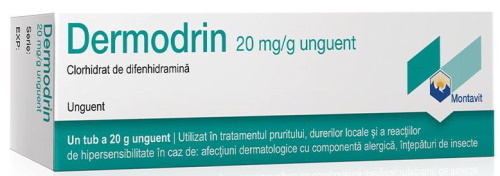
Dermadrin also has the following additional pharmacological properties:
- eliminates the itching sensation;
- relieves swelling of epithelial tissues;
- has a moderate anesthetic effect;
- removes redness and rash;
- cools skin areas that are inflamed by allergens.
The therapeutic effect of Dermadrin ointment is realized immediately after it is applied to the surface of the skin. The healing properties of this medication persist for the next 2-6 hours, depending on the reasons that provoked the allergic reaction.
Dermadrin antihistamine ointment is indicated for use in the following clinical cases:
- dermatosis, accompanied by severe itching of the skin;
- hives;
- the consequences of solar and thermal burns of the 1st degree of severity;
- eczema of an allergic nature of origin;
- local irritation caused by the bites of poisonous insects (bees, wasps, hornets);
- allergic dermatitis.
Dermadrin ointment can be used as an independent antihistamine, or it is used in combination with other antiallergic drugs. This medication is applied externally to the surface of the skin in a dosage of 1 to 3 g. Dermadrin ointment is used 1-2 times a day. The area of epithelial tissues affected by allergies is also taken into account.
The antihistamine Dermadrin has the following contraindications for use:
- individual intolerance to diphenhydramine hydrochloride;
- children under 2 years of age;
- the presence of open wounds in the area of allergic reaction.
This drug is not recommended for patients who have concomitant diseases such as measles, varicose veins, and vesicular lesions of the skin.
Dermadrin ointment is well tolerated by most patients of all age groups. Despite this, doctors do not exclude the possibility of developing a side effect of hypersensitivity. The average cost of Dermadrin ointment is 230 rubles.
Fenistil gel
Fenistil gel is a local antihistamine agent, which is produced on the basis of the active substance dimetindene maleate in a dosage of 100 mg. This drug is completely transparent without a pronounced odor.
Fenistil gel is prescribed for use in the following cases:
- itching accompanied by dermatosis;
- hives;
- eczema of allergic etiology;
- poisonous insect bites.
Fenistil gel is used to treat local irritation that occurs after sun and household burns, which belong to the 1st degree of severity. This drug is applied directly to the surface of the skin with signs of allergies. Fenistil gel is used 2 to 4 times a day. The duration of treatment is determined individually.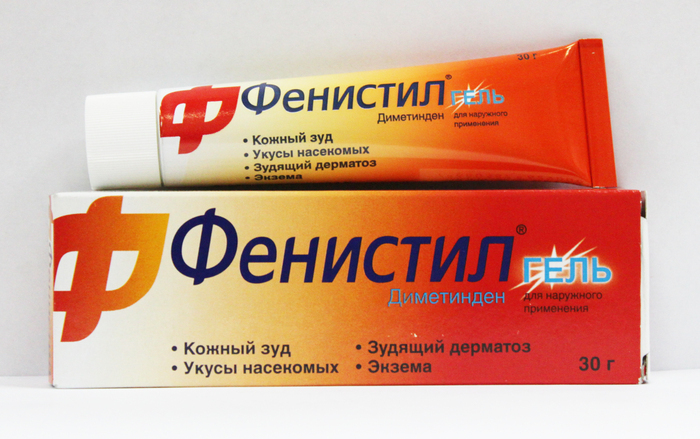
Fenistil gel has the following contraindications:
- angle-closure glaucoma;
- benign prostatic hyperplasia;
- individual intolerance to dimethindene;
- children under the age of 1 month.
Fenistil gel is prescribed with caution to women who are in the 3rd trimester of pregnancy, as well as breastfeeding. During lactation, it is necessary to ensure that the medication does not get on the surface of the nipples.
If a large amount of this drug accidentally gets into the digestive tract cavity, it is possible the appearance of the following symptoms:
- oppression of the functions of the central nervous system;
- tachycardia;
- decrease in blood pressure indicators;
- severe dryness of the oral mucosa;
- visual hallucinations;
- feverish condition;
- delayed outflow of urine;
- attacks of hot flushes of the tissues of the face;
- cramps of the lower extremities;
- ataxia.
Patients with the above signs of poisoning by the constituent components of Fenistil should take activated charcoal, drugs that support the functions of the heart, blood vessels and respiratory organs. It is advisable to use a saline laxative.
During therapy with Fenistil gel, side effects may occur in the form of increased dry skin, redness and burning sensation. In this case, further use of the medication is stopped. The sale of this antihistamine is carried out without a prescription, and its average cost is 310 rubles.
Dimetindene
Antihistamine ointments for skin allergies can get rid of the feeling of itching, redness and swelling of epithelial tissues. The drug Dimetinden is produced in the form of a colorless gel, which is packed in jars and tubes with a capacity of 5 to 100 g, depending on the individual needs of each patient.
The active substance of this medication is dimethindene maleate at a dosage of 0.1 g per 100 g of the finished product. After external application, Dimetindene is rapidly absorbed into epithelial tissues, and its bioavailability in the blood plasma does not exceed 10%.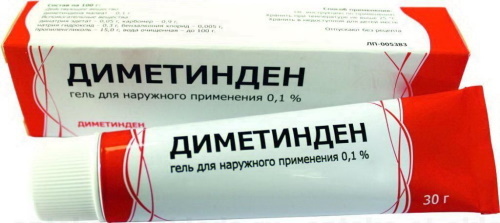
Dimetinden gel is indicated for use in the following clinical cases:
- itchy skin;
- allergic dermatosis;
- hives;
- poisonous insect bites;
- redness of the skin caused by the consequences of minor burns.
The dosage regimen with the drug Dimetinden provides for the treatment of a skin area with signs of allergy, which should be performed 2 to 4 times a day. If severe itching persists, antihistamines for oral administration are added to the therapeutic course.
Dimetindene gel has the following contraindications:
- violation of the outflow of urine;
- hypertrophy of the prostate;
- the patient's age is less than 1 month;
- glaucoma.
Therapy for a child from the age of 1 month. up to 2 years with the use of the drug Dimetinden is possible only after prior consultation with a pediatric dermatologist or allergist.
This medication should not be applied to large areas of the skin of infants and young children. Especially if the local allergic reaction is accompanied by an inflammatory process and constant lymph secretion (as during weeping eczema).
Such conditions of the child's skin require a mandatory examination by a doctor. After applying Dimetinden to the surface of epithelial tissues, it is recommended to completely exclude insolation. It is important to remember that this medication is completely ineffective in the presence of itching, which is caused by cholestasis.
With the simultaneous use of the drug Dimetinden with drugs that can have a depressing effect on the myocardium, their therapeutic properties are enhanced. It is not recommended to carry out the simultaneous use of this antihistamine ointment with tricyclic antidepressants and anticholinergic medications.
Otherwise, there is a risk of a sudden increase in intraocular pressure. In the future, this may negatively affect the performance of the organ of vision. Dimetindene is able to enhance the pharmacological effect of hypnotics and drugs from the anxiolytic group.
Medicines from the pharmaco-therapeutic group of MAO inhibitors, which are used simultaneously with Dimetindene, can enhance the sedative and anticholinergic effect of antihistamine ointment.
During treatment with this antihistamine, it is necessary to stop using ethanol, since the rate of reactions may decrease. This drug does not require a prescription from your healthcare professional. The average cost of Dimetinden antihistamine gel is 290 rubles.
Allergozan
Antihistamine ointments for skin allergies are produced on the basis of substances that are H1 receptor blockers. Allergozan comes in the form of a white creamy ointment without a pronounced odor.
The active substance of this medication is the chemical compound chloropyramine hydrochloride at a dosage of 10 mg per 1 g. Allergozan ointment has an exclusively local effect. Currently, there are no clinically confirmed data that the components of this agent are absorbed into the general bloodstream.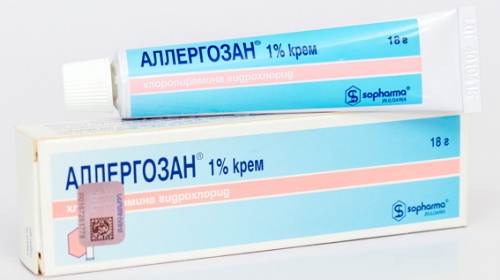
The antihistamine Allergozan is indicated for use in the following cases:
- poisonous insect bites;
- allergic rash;
- itchy skin;
- dermatoses of allergic etiology.
Allergozan ointment is indicated for use by adults and children with its application to the diseased skin area 2 to 3 times a day. The drug is rubbed into the epithelial tissue with slow massaging movements. The duration of therapy is 5 to 7 days.
The antihistamine Allergozan is contraindicated in patients who have hypersensitivity to its constituent components. During treatment with this drug, side effects in the form of redness and itching of the skin are possible. Allergozan is sold without a prescription, and its average cost is 280 rubles. The shelf life of this drug is 1 month. after opening the tube with ointment.
Chloropyramine
Antihistamine ointments for skin allergies act locally, without saturating the composition of the general bloodstream. This minimizes the risk of side effects. Chloropyramine is a white antihistamine with a thick and uniform consistency.
This drug is produced on the basis of the active substance in the form of chloropyramine hydrochloride in a dosage of 0.18 g. The medicine is packaged in aluminum tubes with a capacity of 18 g each. Chloropyramine blocks the sensitivity of H1 receptors, making them immune to histamine.
Chloropyramine is prescribed for use in the following cases:
- local allergic reactions to insect bites;
- hives;
- contact dermatitis;
- dermatosis, accompanied by itching of the skin;
- eczema;
- allergic rash.
Chloropyramine is applied directly to the surface of the diseased skin area 2 to 3 times a day. The ointment is rubbed into the epithelial tissue with slow and massaging movements. The drug is intended for symptomatic therapy for the shortest possible period of time.
It is very important that during the period of treatment with Chloropyramine ointment the source of the allergic reaction is identified. Otherwise, after stopping the use of this medication, a re-manifestation of an allergic reaction is possible.
This antihistamine is contraindicated in children under 1 month of age, as well as in people with intolerance to the substance chloropyramine hydrochloride. Also, this medication is strictly prohibited for use to treat an allergic reaction in premature babies. Chloropyramine is available without a doctor's prescription.
Psilo-Balm
Psilo-Balm is a local spectrum antihistamine, which is a transparent gel with a uniform consistency. The active substance of this medication is the chemical compound diphenhydramine hydrochloride at a dosage of 10 mg per 1 g of the finished drug. Psilo-Balm is produced in aluminum tubes with a capacity of 20 and 50 g.
This drug is indicated for use in case of the following symptoms of an allergic reaction:
- eczema;
- itching;
- hives;
- irritation after a bite of poisonous and blood-sucking insects;
- skin rash;
- hyperemia of epithelial tissues;
- contact dermatitis.
The dosage regimen with the Psilo-Balm medication provides for the application of a thin layer of ointment on the diseased area of the body in an amount of 2-3 g. The drug is used 3 to 4 times a day.
During treatment with this antihistamine, the following side effects may occur:
- increased dryness of the skin;
- redness of epithelial tissues;
- the onset of a burning sensation that appears immediately after treatment of the skin with Psilo-Balm ointment;
- strengthening of the general signs of an allergic reaction, which indicates an individual intolerance to the constituent substances of the drug.
The use of Psilo-Balsam is contraindicated in patients who are hypersensitive to its active and auxiliary components. This medication is dispensed without a prescription, and its average cost starts at 251 rubles.
Dimetinden-Akrikhin
Dimetindene-Akrikhin is an odorless antihistamine gel that is completely colorless. The active ingredient of this drug is dimethindene maleate with a concentration of 1 mg per 1 g of the finished medication.
The mechanism of action of Dimetindene-Akrikhin gel is that its active substance blocks the sensitivity of histamine H1 receptors. A distinctive feature of this drug is that it can be used internally, and is also used for external application.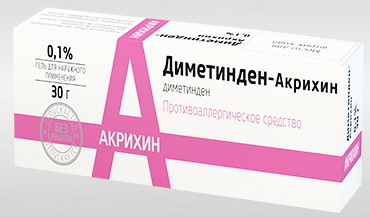
Dimetinden-Akrikhin gel is prescribed to patients who have been diagnosed with the following signs of an allergic reaction:
- itching of the skin;
- edema of epithelial tissues;
- hives;
- hyperemia;
- skin irritation caused by sunburn.
Patients who have signs of skin allergies apply Dimetindene-Akrikhin gel directly to the diseased areas of the epidermis. Treatment of epithelial tissues is carried out 2 to 4 times a day. The duration of treatment is determined individually by an allergist or dermatologist.
Dimetindene-Akrikhin is contraindicated for use in the following cases:
- hypertrophy of the prostate in men;
- the patient's age is less than 1 month;
- individual intolerance to the chemical dimethindene;
- angle-closure glaucoma.
In the process of antihistamine therapy with Dimetinden-Akrikhin gel, patients may experience the following side effects of this drug:
- increased dryness of the epidermis;
- burning sensation;
- redness of the skin;
- local allergic reactions.
In case of side effects, it is necessary to immediately stop further use of the Dimetindene-Akrikhin gel, and also consult your doctor for additional advice. The average cost of this medication is in the range of 290-300 rubles. The release of the drug Dimetinden-Akrikhin is carried out without a prescription.
When symptoms of skin allergy appear, antihistamines are used in the form of ointments, gels and creams that relieve swelling, redness, and itching of the skin. The mechanism of action of drugs in this category is to block the sensitivity of the H1 receptors, which are responsible for the recognition of histamine.
All ointments with antihistamine properties are intended for symptomatic therapy. These drugs eliminate pathological symptoms, but do not remove allergens from the body that provoke skin irritation. Most antihistamine ointments are available without a doctor's prescription.
Video about antihistamine ointments
Ointments for skin allergies in adults:



